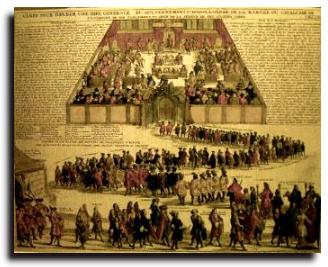

Despite, or because of the Union of Parliaments, this is a period in which fine craftsmanship and the industrial revolution played their part in the development of Scotland.
Union of the Parliaments 1707
The picture at the top of this page shows the Scottish Members of Parliament, in procession, as they wend their way to the final session before the Act of Union in 1707. It meant a loss of independence and control for nearly 300 years but also opened the way to the development of trade and markets for Scottish goods in both England and the rest of the world.
Development of Banking
The first commercial bank in Scotland was founded by an Act of the Scottish Parliament in 1695. It is one of the peculiarities of history that while it was a Scotsman, William Paterson, who prompted the establishment of the Bank of England, it was an Englishman, John Holland, a London merchant, who was most closely association with the foundation of the Bank of Scotland. Holland went on to serve as the Scottish bank’s first Governor although most of the support for the new company came from citizens of Edinburgh or from Scots settled in London. And banking and financial services have become one of the major success stories of Scotland over the last 300 years.
The bank note illustrated here was issued by the Royal Bank of Scotland (founded in 1727 by Royal Charter and derived from a society set up to manage the funds allocated by the Act of Union to compensate subscribers in the disastrous Darien Scheme). The value is "one guinea" or 1.05 pounds sterling. This note was issued in 1777 and was the first bank note in the world to be printed in colour (King George III's head is printed in red).
The Clearances
At the end of the 18th century and throughout the 19th and into the 20th century a significant number of people left Scotland to start a new life in North America, Australia, New Zealand and many other corners of the globe. A major factor was the forcible eviction of crofters by landowners who believed they could earn more by rearing sheep than from the rent from the subsistence farming carried on by their tenants. A growing population and poor harvests also played a part - there were many emigrants from parts of Scotland other than those from the Highlands.
This illustration was one of a large number projected as part of a slide show showing the emigrants and their contribution to the countries which became their new homes.
Bute Snuffbox
The development of craftsmanship and the creation of elegant art objects blossomed. This beautiful snuffbox was given by King George III to the Earl of Bute.
Mass Production

Mass production did not necessarily make objects less attractive. On the left are plates made by the Delftfield factory in Glasgow which was established in 1748. On the right, everyone will recognise the "Paisley Pattern" textiles which took the name of Glasgow's near neighbour round the world
Heavy Industry
Initially, many of the wooden ships which carried the tobacco, sugar and cotton from America to Scotland were built in North America using the plentiful supply of timber there. But the development of steam power (Henry Bell built the first commercially viable steamboat, the Comet, on the lower Clyde in 1812) and iron clad ships created a major shipbuilding industry in Scotland, particularly along the banks of the River Clyde.
The model illustrated here is the "Empress of Scotland" built for the Canadian Pacific Steamship Company by Fairfields of Govan.
Not a model this time but a full size steam train!
More Pages on the Museum of Scotland
Return to the Main Index of Places to Visit
Where else would you like to go in Scotland?

